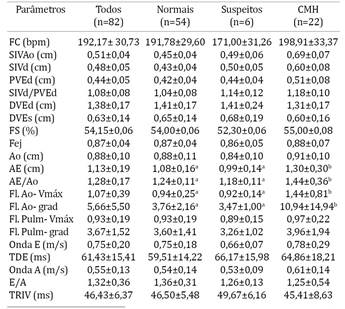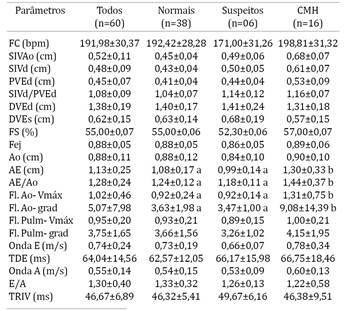Abstract:
Hypertrophic cardiomyopathy (HCM) is the most common feline heart disease and is characterized by increased cardiac mass with a hypertrophied and not dilated left ventricle. The echocardiography is the best noninvasive diagnostic tool for the differentiation of cardiomyopathies and is considered the gold standard for detection of ventricular hypertrophy present in HCM. Electrocardiographic changes are also common in animals with HCM and the electrocardiogram (ECG) is quick, easy and highly available screening test for the detection of ventricular hypertrophy in humans. In cats, few studies have been conducted regarding the sensitivity and specificity of ECG in detecting ventricular hypertrophy. With the intention of evaluating the use of ECG as a screening tool for diagnosis of HCM in cats, Persian cats (n=82) were evaluated by echocardiographic and electrocardiographic examinations. Animals with blocks and/or conduction disturbances were excluded from statistical analysis (n=22). Subsequently the animals included were classified as normal (n=38), suspicious (n=6) and affected by HCM (n=16). Statistical differences were observed in the P-wave amplitude in DII and R-wave amplitude in DII, CV6LL and CV6LU, with higher values in animals with HCM. Velocities and pressure gradient of aortic flow, left atrial diameter (LA) and LA/Ao ratio were higher in cats with HCM. Among the animals with ECG changes suggestive of left atrial enlargement (n=7), only two actually had LA enlargement on echocardiography, and among animals with left atrial enlargement on echocardiogram (n=7), only two had ECG changes suggestive of overload AE (40,4% of sensibility and 90,9% of specificity). Among the animals with ECG changes suggestive of left ventricular hypertrophy (n=6), five actually had ventricular hypertrophy on echocardiography, and among animals with HCM by echocardiography (n=16), only five showed electrocardiographic abnormalities suggestive of LV hypertrophy (31,25% of sensibility and 97,72% of specificity). We observed a positive correlation between diastolic thickness of the interventricular septum and/or left ventricular free wall and R-wave amplitude in DII and CV6LU. The electrocardiogram is quick and easy to perform, has good specificity in detecting ventricular hypertrophy in cats, however, has low sensitivity, with large numbers of false negative animals. Thus, the ECG assists in the diagnosis, but does not replace echocardiography in confirming ventricular hypertrophy.
Index Terms:
Electrocardiography; hypertrophic cardiomyopathy; cats; Persian; echocardiography





